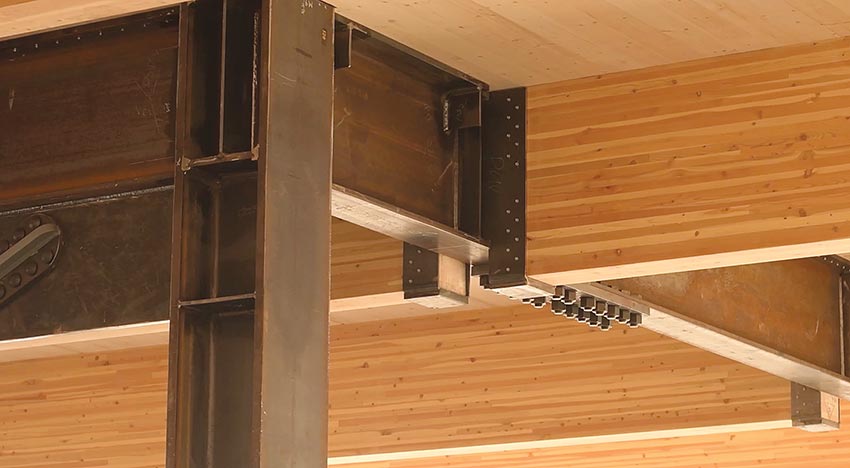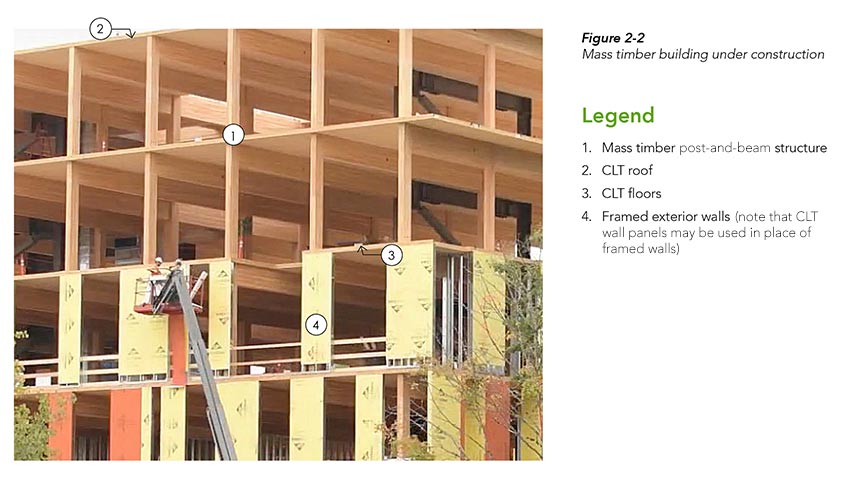Embracing the Timber Age
Learning Objectives:
- Explain the benefits and growing popularity of cross-laminated timber (CLT) buildings.
- Recognize CLT’s unique sensitivity to moisture and how specially designed building enclosures are required to support building longevity and high performance.
- Review options for attaching various cladding components to the CLT panels.
- Describe best practices for designing and installing water-resistive barriers (WRBs), vapor retarders, and air barriers (ABs) in CLT wall and roof cladding systems.
- Review best practices for detailing CLT roof assemblies of varying slopes.
Credits:
This course is approved as a Structured Course
This course can be self-reported to the AANB, as per their CE Guidelines
Approved for structured learning
Approved for Core Learning
This course can be self-reported to the NLAA
Course may qualify for Learning Hours with NWTAA
Course eligible for OAA Learning Hours
This course is approved as a core course
This course can be self-reported for Learning Units to the Architectural Institute of British Columbia
Driven by climate change concerns and sustainable design trends, structural wood is slowly but surely gaining traction. In fact, the worldwide market for cross-laminated timber (CLT) is expected to grow at a compound annual growth rate of approximately 9.1 percent over the next five years, reaching $980 million by 2024, states the Selbyville, Delaware-based market research firm Market Study in its “Cross-Laminated Timber Market Share” report.

All images, figures, and details courtesy of VaproShield and RDH Building Science
“This is the beginning of the timber age,” declares Andrew Waugh, RIBA, founder and director, Waugh Thistelton Architects, London, in a Dezeen article on this noted trend. “Building in wood is super fast, super accurate, and also makes the most amazingly beautiful spaces.”
Waugh claims that a CLT structure can be constructed 50 percent faster than a concrete building, requires fewer deliveries to the site, and provides a more pleasant environment for construction workers.
Architect Alex de Rijke, whose London-based firm dRMM has designed a few dozen CLT buildings, agrees, saying, “CLT is the future of construction. Timber is the new concrete.”
In an Economist video report titled “Wooden skyscrapers could be the future for cities,” Michael Ramage, Ph.D., director, Cambridge University’s Center for Natural Material Innovation, even goes so far as to say, “I think it’s very realistic to think that someone will build a wooden skyscraper in the coming years. Wooden skyscrapers could be the future for cities. There is a lot of potential that’s unrealized for using timber at a very large scale.”
Although the CLT building trend is stronger overseas, North America is coming on board with a 250,000-square-foot mass timber manufacturing plant going up in Spokane Valley, Washington, and another 227,000-square-foot CLT plant under construction in Dothan, Alabama.
While the potential is exciting, this fairly new renewable building type brings along with it a unique set of building enclosure challenges.
As a moisture-sensitive material, wood is slow to dry if wetted due to its hygric mass. Furthermore, wetting for prolonged periods can result in dimensional changes, moisture damage, and microbial growth. As a result, keeping CLT products dry during construction and throughout the building’s service life is critical. The speed at which CLT panels may be erected also creates unique field challenges where CLT panels are exposed to the elements for periods of time while awaiting cover.
Filling this unique niche of providing water-resistive-barrier (WRB) and air-barrier (AB) membranes and roof underlayment, very few technologies are ideally suited for the challenges specific to mass timber construction.
One such technology is vapor-permeable sheet membranes that simultaneously manage bulk-water infiltration while allowing for accelerated drying of the underlying materials. As a self-adhered WRB that bonds directly to wood substrates, no primers are required, so the membrane installation can proceed simultaneously with the CLT panel erection process. This technology also lends itself to WRB/AB pre-application, taking advantage of the prefabrication process inherent to CLT panel construction, and the quality control and weather protection that shop fabrication can provide.

Figure 1-2
At the Hawker Architects-designed First Tech Credit Union in Palo Alto, California, a cross-laminated timber (CLT) floor is supported by a glue-laminated timber structure.
Mass Timber
Before delving into the specifics of how to properly detail a CLT enclosure, some background on this newer building material is helpful.
Modern mass timber buildings are constructed of engineered wood products, often manufactured from multiple layers of sawn lumber, attached to form a solid panel, beam, or column. By forming solid wood sections, mass timber differs from the conventional, lightweight wood-framed construction that has long dominated the low-rise residential construction market in North America.
Among the mass timber materials known for their sustainable, renewable properties, CLT is the most popular. These panels offer strength, rigidity, and dimensional stability, making them ideal for floor, wall, and roof applications. CLT’s panelization potential also lends itself to streamlining the construction process and dramatically shortening the construction schedule while employing less labor
A number of other mass timber products widely used across North America offer similar benefits to CLT. They include nail-laminated timber (NLT), dowel-laminated timber (DLT), interlocking cross-laminated timber (ICLT), glue-laminated timber (GLT), vertically laminated veneer lumber (LVL), and laminated strand lumber (LSL). Multiple mass timber products can be used in the same building. For instance, Figure 1-2 shows an example of a CLT floor supported by a GLT structure.
While the primary focus of this course is CLT building enclosure design, much of the information applies to other types of mass timber products as well.
This course covers best practices for the design and construction of high-performance CLT wall and roof assemblies using suitable vapor-permeable WRB and AB membranes, roof underlayments, and flashing accessories in moderate to cold North American climates, including International Energy Conservation Code (IECC) Climate Zones 4 through 8. While CLT assemblies in warmer climates are not covered, these building enclosure products may still provide solutions for a successful enclosure design in these regions. Of course, these products can also be used with many other forms of mass timber, wood-framed, and conventional construction methods following similar installation techniques and detailing.
CLT Building Enclosure Design
The building enclosure, also known as the building envelope, separates interior building spaces from the exterior environment. In the context of CLT mass timber construction, the enclosure may be composed of vertical panels at exterior walls and horizontally laid or sloped panels at the roof. Interior floors may also be constructed with CLT or other panelized mass timber products. The internal mass timber structure may be provided by GLT, LVL, or similar structurally engineered wood products in a post-and-beam layout. Of course, not all mass timber projects must be constructed exclusively with wood products, and many hybrid construction combinations are possible, such as a structural concrete or steel core with a CLT enclosure, or a mass timber structure with a more traditional framed wall enclosure, as shown in Figure 2-2.

Project: First Tech Credit Union, Architect: Hacker Architects
Over its service life, the building enclosure is subjected to environmental loads of water, air, heat, and water vapor in addition to other loads, such as fire, smoke, light, sound, and insects. The enclosure must also counteract lateral wind loads and provide support of its own weight and other vertical loads if it is load bearing. These loads are transferred back to the building’s primary structure. Thoughtful design of the building enclosure considers all loads imposed on the enclosure over its service life, but this course will focus on controlling the water, air, heat, and water-vapor loads that act on the enclosure.
While CLT panels can be designed to meet the anticipated structural loads, CLT alone is not capable of adequately controlling air, water, heat, and water vapor. Thus, CLT must rely on an assembly of materials and other components to meet the building’s performance expectations. Performance can have a variety of meanings, but in the context of this course, it demonstrates a building enclosure that will effectively manage water (both liquid and vapor), reduce the building’s need for heating and cooling energy, and minimize the unintentional exchange of air between the interior and exterior environments.
Design and performance considerations for CLT enclosures differ from those of more traditional lightweight or mass concrete enclosures. CLT has unique physical properties, including its moisture sensitivity, relatively high capacity to store moisture, and relatively low vapor permeability.
Environmental Loads
The outdoor environment will vary depending on climate and local site conditions, and the indoor environment will differ by building use and occupant behavior. Thus, climate, microclimate, site conditions, and building use and operation are all important considerations when evaluating the environmental loads acting on the enclosure. Liquid water—predominately rainwater, but also snow melt and runoff—is typically the most critical environmental load. Other environmental loads—air, heat, and water vapor—are caused by differences between the indoor and outdoor conditions.
Water
With a higher sensitivity to moisture, rainwater exposure is a major issue with wood products.
If water contacts CLT surfaces for a prolonged period, particularly if exposed at the wood’s end-grain, the wood panel may absorb water, increasing its moisture content. Wood expands and contracts with changes in moisture content, so wetting of CLT will cause dimensional changes, potentially opening up gaps between laminations and panel interfaces that can adversely affect the aesthetic qualities and long-term performance of CLT. When dimensional changes occur too quickly, this can also cause CLT surface checking or cracks, which may allow water to penetrate further into the panel or cause visual irregularities if exposed to view. Prolonged exposure to moisture may also cause decay, microbial growth, corrosion of metal fasteners and connections, and potential damage to the interior finish if the panel is intended to be exposed. Limiting the CLT exposure to water during both construction and building service can reduce these risks.
In North America, the amount of annual rainfall can vary from low in desert and arid climates to more extreme levels in coastal regions. Rainfall levels can be exacerbated by high wind speeds resulting in wind-driven rain (i.e., driving rain). Wind speeds generally increase with height; thus, taller wood buildings made possible by CLT and other mass timber innovations are likely to see greater water loads than traditional wood-framed structures.
When rain falls can be as important as how much rain falls. This is because the seasonal distribution of precipitation can affect the drying potential of the enclosure after a wetting event. For example, a heavy rainfall followed by colder temperatures and/or high humidity levels provide little opportunity for drying. This consideration can have a significant impact on CLT panels that may have been erected but are not yet properly protected from construction-phase moisture.
While wall-cladding and roof-finish elements in a sloped roof application are responsible for shedding liquid, water is expected to bypass these elements at some point during the building’s service life due to natural deterioration of the materials or construction defects.
Additionally, some cladding and finish systems are designed in a discontinuous manner, such as open-joint cladding systems. As a result, a WRB or roof membrane/underlayment is necessary to protect the CLT, structure, and interior finishes from water ingress. A number of products are designed to serve this function by resisting bulk-water infiltration, with select products also offering extended UV and high-temperature stability.















